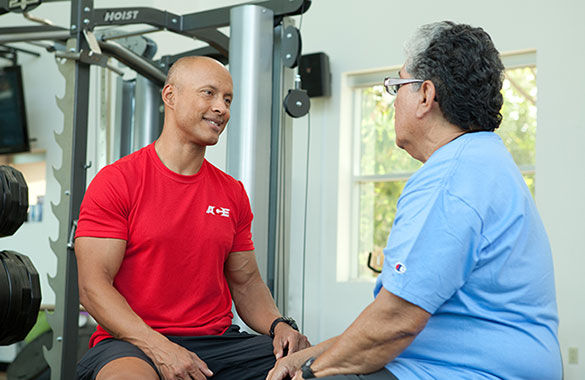
When it comes to your personal training style, which type of fitness trainer do you relate to more—the trainers on The Biggest Loser…or Richard Simmons?
Do you project a “tough love” kind of attitude onto your clients, feeling that if you don’t push them hard enough, they won’t see the results they want? Do you have a “no excuses” rule with them, negating whatever reason they have for not following through with their goals? Do you feel that shaming them on some level is an appropriate punishment to get them to “shape up”?
Or do you take a softer approach with your clientele, attempting to understand where they’re coming from, trying to see their world through their eyes and encouraging them from a place of understanding and empathy?
What Is Empathy?
Empathy is walking a mile in someone else’s shoes. It’s seeing things from their perspective. Webster’s online dictionary defines empathy as "the projection of one’s own personality into the personality of another in order to understand the person better; [the] ability to share in another’s emotions, thoughts or feelings.” It’s rooted in the Greek empathei, meaning affection or passion.
“Empathy helps us learn what is really on people’s minds by seeking to understand their needs and emotions,” explains Joan Pagano, owner of Joan Pagano Fitness in NYC and author of Strength Training Exercises for Women (DK, 2014). “It is psychological identification: When we see the world through their eyes and understand their perspective, people naturally trust us more, because they believe that we have their best interest at heart.”
Pagano believes that taking an empathetic approach is the best way to engage clients and get results. “As they continue to evolve, and you continue to empathize, you can develop long-term relationships that are productive to the client and gratifying to the trainer.”
Natalie Muth, M.D., ACE Senior Advisor for Healthcare Solutions and ACE Certified Health Coach, agrees. “A supportive relationship rooted in empathy is going to be most impactful and help to support clients in achieving their goals.”
But what about the television trainers who crack the whip and push their clients with that tough love approach? They see results, too, don’t they?
“Every client is different and will respond differently to a tough-love approach,” says Muth. “It is really important for trainers to listen carefully to their clients and try to get a sense of their goals and also how they are best supported in achieving them.”
“Tough love, an expression used when someone treats another person harshly or sternly with the intent to help them in the long run, is a balancing act,” interjects Pagano. “Too little can be ineffective in producing results, while too much can be demotivating, making the client feel unable to meet the demands. It needs to be used sparingly and at the right time. An unrelenting militaristic style of training, which we’ve all seen on TV, can be both demoralizing and humiliating. Ask yourself: Do you want to be responsible for creating this kind of mental state in another person?”
Other trainers, however, believe that, when used correctly with the appropriate client, tough love can be beneficial. “If I’m training a youth athlete or a person preparing for a fitness competition, I find I can issue a little more tough love than if I’m training a person just returning to a regular gym schedule who may need to build more confidence and strength,” explains Corey Phillips, a certified personal trainer for Gold’s Gym Dutchess County in Poughkeepsie, N.Y., and starting forward for the Kingston Stockade Football Club. “There’s a delicate balance between pushing clients to work harder than they thought they could and working them too hard and discouraging them from returning the next session. I like to check in throughout our session to make sure I’m walking on the correct side of this fine line.”
Can You Be Too Empathetic?
On the other side of empathy is enabling. Could being too empathetic turn into enabling your clients on some level?
“Enabling, in a psychological context, starts as an attempt to be kind and helpful by doing something for others that they should be able to do for themselves,” explains Pagano. “You essentially take away any motivation for change by allowing them to stay in their comfort zone without creating new personal growth. Empathy, on the other hand, encourages growth in the client by your ability to identify with their present state and move them forward from there.”
In an article published by the Cognitive Neuroscience Society, Tania Singer, director of the department of social neuroscience at the Max Planck Institute for Human Cognitive and Brain Sciences in Leipzig, Germany, argues that empathy can be detrimental if taken too far. She prefers compassion to empathy, as she believes that by empathizing with someone, you end up feeling their pain and suffering, as well. She says the suffering could become so intense that it could, in turn, cause empathic distress and ultimately burnout.
Whether you decide to call it compassion or empathy, as with many other things in life, having a healthy boundary with either is necessary to avoid becoming too wrapped up in other people’s “baggage.”
What If You Have a Difficult Time Empathizing With Others?
If you’re not naturally an empathetic person—but you’d like to be—here’s some good news: Research suggests that empathy (specifically, the lack of it) may have a genetic component. This doesn’t mean, however, that you’re doomed to be a self-centered narcissist if you carry this gene, as other studies have identified the regions of the brain that are linked to empathy and compassion. So, while you can’t change your genes, you can train your brain. In fact, researchers at the Center for Investigating Healthy Minds at the Waisman Center of the University of Wisconsin-Madison liken training your brain to strength training.
“It’s kind of like weight training,” says Helen Weng, lead study author. “Using this systematic approach, we found that people can actually build up their compassion ‘muscle’ and respond to others’ suffering with care and a desire to help.”
The systematic approach Weng is referring to is a method called “Loving Kindness Meditation” (LMK). In the meditation, participants in the study envisioned a time when someone had suffered and then practiced wishing that his or her suffering was relieved. They repeated phrases to help them focus on compassion such as, “May you be free from suffering. May you have joy and ease.”
Participants practiced with different categories of people, including loved ones and other people they would consider difficult, such as a challenging co-worker. Additional methods were used with the participants including listening to guided audio instructions and playing a game in which they were asked to contribute money to people in need whom they had never met.
When compared to the control group, which was taught an emotional regulation technique called cognitive reappraisal, the group that was taught empathy training showed definite changes in the brain during functional magnetic resonance imaging (fMRI). Specifically, they found that activity was increased in the inferior parietal cortex, a region involved in empathy and understanding others. Compassion training also increased activity in the dorsolateral prefrontal cortex and the extent to which it communicated with the nucleus accumbens, both of which are brain regions involved in emotion regulation and positive emotions.
Or you could do what Drew Manning did to become more empathetic.
Manning made headlines when he gained and lost 70 pounds in a year so that he could gain more perspective of what his clients go through when trying to get fit and lose weight. According to his wife in a CNN article, prior to completing this challenge, he was a judgmental trainer who equated being overweight with being lazy. Gaining and then losing 70 pounds helped him see things from a different perspective.
Christopher Bergland, author of Psychology Today's blog, The Athlete's Way, believes that regular physical exercise and plowing through a tough workout makes people more empathetic to human suffering.
Empathy and compassion aren’t the only benefits to practicing Loving Kindness Meditation. Read about 16 more science-based reasons to consider this simple practice.
“Some people may think that pushing yourself through a workout is masochistic. It is. This is one reason why daily physical exercise might make anyone less sadistic or likely to be a psychopath at a neurological level,” he explains in one of his blog posts. “You viscerally connect to the essence of human struggle experienced everyday by people around the world who are less fortunate than many of us. This is one of the founding principles of The Athlete's Way: Sweat and the Biology of Bliss” (St. Martin’s Press, 2007).
“I would say that an empathic style of training has been the key to my success as a personal trainer, with a dedicated client base for 28 years,” concludes Pagano. “The ability to identify with the client’s needs as they change over time keeps us both engaged in their process of growth and development. And it’s enlightening to me, too. When my clients share their personal experience of health and fitness—whether achieving personal goals, going through a transition, such as recovering from illness or injury, or just managing the aging process—they increase my knowledge base and enhance my professional skills. It’s a total win-win!”





 by
by 


